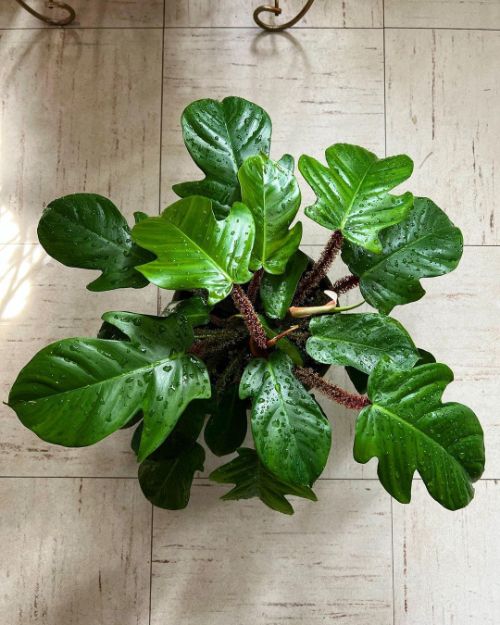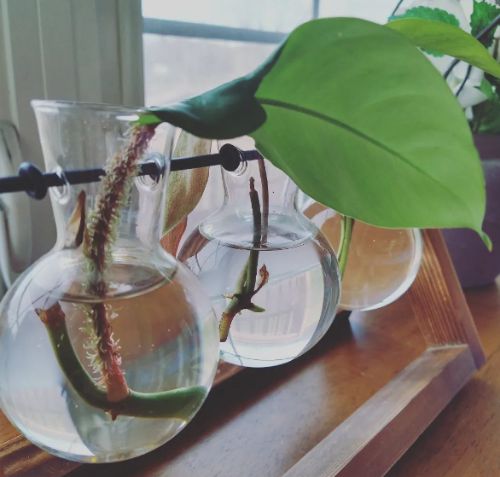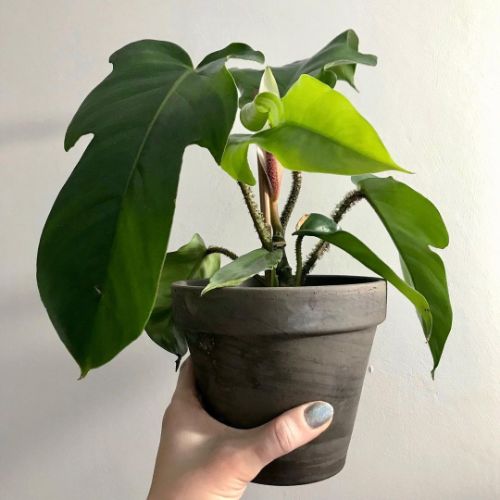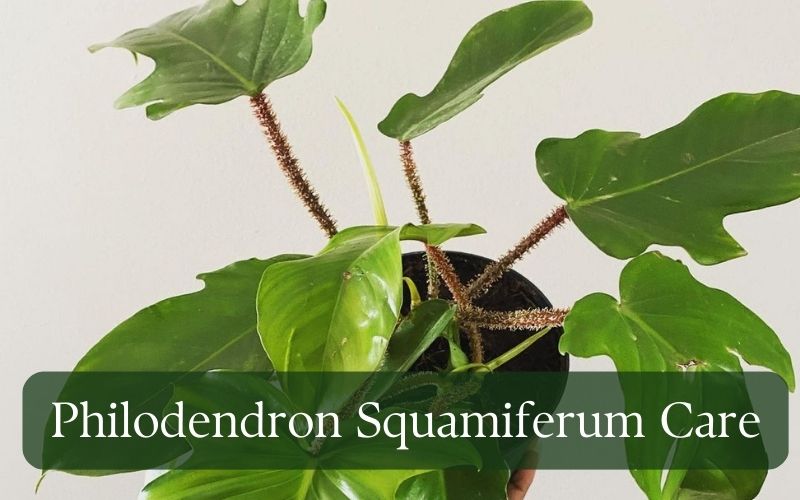The Philodendron Squamiferum is just the right pick to jazz up your indoor garden if you’re big on plants. This tropical dude is getting more and more popular with houseplant junkies ’cause it’s got a pretty cool look. But, just like any other plant, to thrive, it needs your love and attention.
This go-to guide will walk you through all the ins and outs of Philodendron squamiferum care. From where it’s happy growing, to common problems and how to solve them – we’ve got it all covered here. Whether you’re an old hand at plants or a fresh newbie, this guide’s gonna help you keep your Philodendron Squamiferum looking good and feeling healthy for a whole lotta years. So, let’s dive in!
About Philodendron squamiferum
The Tropical Philodendron squamiferum is a plant that comes straight from South America, more specifically, French Guiana, Suriname, and the northern part of Brazil.
This plant is part of the Araceae family, and just like its Philodendron cousins, it has some cool features. One thing that sets it apart is its fuzzy, reddish stems.
You know, the Monstera Deliciosa, Philodendron Bipennifolium, and Philodendron Pedatum? Yeah, they’re all sort of like family to the Philodendron Squamiferum, and they look a bit similar too. The leaves of this plant are kind of special, with several sections and a pattern that reminds you of an oak tree.
Big, heart-shaped leaves that can get up to 12 inches long, and red stems with a bristly feel, those are the things that make the Philodendron squamiferum unique. The leaves are a deep green color with noticeable veins, and sometimes, you might even spot silvery specks on the surface. In the best conditions, this plant can shoot up to a whopping 10 feet tall and it’s often seen doing a bit of climbing.

Philodendron squamiferum Care overview
| Scientific Name | Philodendron squamiferum |
| Common Name | Hairy Philodendron, Red Bristle Philodendron |
| Family | Araceae (aroids or arum family) |
| Native habitat | Suriname, French Guiana, and Northern Brazil’s Amapà State. |
| Mature Size | Up to 18 inches in length |
| Bloom Time | Every May to July, once a year |
| Light | Partial shade; Bright, indirect light |
| Soil Type | Coarser, lighter, well-drained, rich in organic matter |
| Soil pH | Moderate to Slightly acidic (5.6 to 6.5) |
| Watering | Medium |
| Temperature | 50°F to 77°F (10°C to 25°C) |
| Humidity | 60% or more |
| Fertilizing | Fertilize once a month during the growing season |
| Repotting | Late spring or early summer (every 2 years) |
| Pruning | Best done in spring or fall |
| Propagation | Stem cuttings |
| Toxicity | Very toxic to both people and pets |
Philodendron squamiferum Light Requirements
Just like nearly all other philodendrons, the Philodendron squamiferum is a jungle-loving plant that does best in bright, indirect light.
Try spinning the plant around once a month to stop it from growing all weird and lopsided.
If the leaves start getting a bit burned, that means too much direct sunlight. During spring and summer, you can pop your squamiferum outdoors under a big tree or on a shaded patio. If it’s an indoor plant, stick it near a window that gets a good dose of light.
If there isn’t enough sunlight, chucking in some LED grow lamps can help meet the squamiferum’s light needs. It can cope with low light, but too little can make the stems grow tall and spindly. To make the plant really thrive, you gotta keep the light just right most of the time.

Soil for squamiferum plant
Philodendron squamiferum isn’t a fan of packed-in soil.To grow, its roots require some air.
When it comes to the pH for Philodendron Squamiferum’s soil, you’re looking at something between 5.1 and 6.0. (So, just a touch on the acidic side).
You’ll want to use garden soil that’s a mix of draining potting soil, coco coir, sphagnum moss, and a bit of pine or orchid bark. This combo’s got loads of air spaces around the roots, making for quick drainage. You can make it even better by chucking in some perlite/vermiculite or pebbles.
Coco coir and sphagnum moss are great for holding onto moisture. Any extra water will head out of the pot’s bottom, thanks to the perlite and pebbles. Mix these with your regular potting soil and you’ve got yourself a light, airy soil blend.
Apart from being good at letting water in and out, the soil for your Philodendron squamiferum should be pretty fertile too. You can supercharge the nutrient content by mixing in some organic matter.
Steer clear of soil that’s too clay-like or sandy if you want your Philodendron Squamiferum to be healthy and happy.
Philodendron squamiferum Watering
Remember, this Philodendron squamiferum isn’t too crazy about water. It really can’t handle being waterlogged, so you gotta keep an eye on the wetness level.
Here’s a cool tip – hold off watering squamiferum until the top bit of soil feels dry. This makes sure the soil isn’t hoarding any extra water. That way, you stop water from pooling and nix the risk of root rot.
Figuring out the perfect watering schedule for any houseplant can be a bit of a head-scratcher, but you’ll do just fine if you keep tabs on the soil and leaves.
The exact amount of water your Philodendron squamiferum needs depends on stuff like the pot size, where it’s hanging out, the type of soil you’re using, and the light situation.
Want a more reliable method? Use a moisture meter to check how damp the plant is before watering it.
A good rule of thumb is to water your Philodendron Squamiferum about once a week in the summer and every other week in the winter, provided it’s got plenty of light and is growing in loose soil.
Heads up, the Squamiferum is one of the Philodendrons that are super sensitive to water, so avoid drowning it. If you see the stalks going all mushy or the leaves wilting, you might be overdoing the watering.

Philodendron squamiferum care Temperature
The philodendron squamiferum is a tropical shrub that enjoys warm climates.
Squamiferum thrives best
when it’s between 50°F and 77°F (10°C and 25°C). If it gets colder or hotter than that, it could take a hit, especially if it goes on for too long.
Squamiferum’s cool with any normal indoor heat. But if you chuck it outside during the summer and it gets too hot, it might start drooping.
Squami can’t handle the cold or frost. When it starts getting chilly at night, around the 50s (F), better bring it inside. And come winter, you might need to move them somewhere a bit warmer and sunnier.
Remember to keep them clear of cold spots like right in front of fans or air conditioners.
Philodendron squamiferum care Humidity
Squamiferum types dig damp places, you know, they’re jungle guys. If you’re lucky to live in a tropical place, your plant will get comfy real quick. If not, it’s no big deal, just plonk a humidifier near your plant and aim for 60 – 65 % humidity.
Caring for a Squamiferum is easy like eat a piece of cake. You don’t really have to use a humidifier, but keeping the humidity over 50% will get your plant growing faster. Try not to put the plant in a spot with air conditioning.
You can also try the pebble tray trick to keep the humidity up all day. Just grab a tray, chuck in some water and tiny pebbles, then pop your plant on top. The water will evaporate and give your plant some extra moisture.
To spread out the humidity, you can also group all your indoor plants together.
Keep the air stirring while you manage the humidity around the plant, ’cause if the humidity goes over 60% without it, you might end up with a funky fungus problem.
If Philodendrons don’t get the right humidity, they can dry out and get brown leaf tips. But too much wetness can attract unwanted bugs and pests, so watch out.
Related: Philodendron Rugosum Care And Growing: The Best Guide
Fertilizer for Philodendron squamiferum
Philodendron squamiferum has moderate growth rates and is not a heavy fertilizer user. Throughout the spring and summer growing seasons, fertilizing it every one to two months should suffice. To ensure an even distribution, spread the fertilizer 5–6 inches away from the plant.
Because the plant enters a dormant state in the winter, avoid fertilizing. Give the plant time to recuperate from too much fertilizer. Whenever spring arrives, you can resume fertilizing. Apply a philodendron-specific fertilizer.
If you’re using one of those slow-release fertilizers, feed the plant about three times a year. This helps it grow nice and healthy. If you’re not sure about what food to give, go for something that’s made just for philodendrons.
After the summer, make sure to wash out the soil to avoid salt buildup. This can help prevent leaf spots, which can show up if the plant gets too stressed out by fertilizer.
Philodendron squamiferum care Propagation
Make sure to clean up your gardening tools before you start, you don’t want any tiny bugs or fungus on them. Don’t forget to put on gloves if you need to.
If you’re going for stem cuttings, here’s the plan:
- Grab a knife or something sharp, and cut off a piece of the Squamiferum stem, around 2-3 inches should do it. Make sure your cutting has a node or growth point near the bottom, one to two leaves, and it’s several inches long.
- Find a decent jar and fill it with water, just leave about an inch at the top if you’re planning to stick this stem cutting in water. Leave the water alone overnight to get rid of any yucky stuff that might be in there.
- Pop the stem cutting into the jar, making sure at least one or two nodes are under the water. You should have two or three leaves peeking out of the water.
- Now find a nice spot for your jar, somewhere bright and moist, and sit back and watch your cuttings grow.
- You can change the water every couple of days if you want to.
- As soon as you see roots starting to pop out, shift the plant into a soil pot.
For the first week or so, keep the soil damp, and put your new baby Squamiferum somewhere warm with some nice indirect light. If your cutting looks a bit stressed after moving, don’t worry; it’ll bounce back soon enough.
Once it starts growing more roots, find it a bigger pot so it can really get growing. You’ll usually start seeing roots pop up after a couple of weeks. After about 2-4 months, you should have a fully grown plant.

Repotting Philodendron squamiferum care
You gotta repot your Philodendron squamiferum like, every couple of years, or when the dude has grown twice as big. You can tell it’s time when the roots start popping out of those drainage holes.
Switching your squamiferum to a slightly larger pot comes with a bunch of good stuff. The roots get more room to chill out. Plus, it’s a great setup for all the stuff it needs, like water and minerals.
Find a pot that’s only about two inches larger. Get some new potting soil in there. Next, move your entire plant into its new digs. Give it a good water, then drain off any leftovers.
You gotta make sure that new pot is big enough, has great drainage, and is airy, nice and breezy. Plastic nursery pots are ace for this kinda job because they’re great for the plant’s roots and you can easily hide them in a fancier pot.
The best time to repot your Squamiferum is during spring and summer, ’cause that’s when it’s in the growth zone.
Philodendron Squamiferum Common Pests & Plant Diseases
Philodendron squamiferum is a tough plant that doesn’t get sick much, but like all plants, it can still get hit by some pests and diseases.
Pest
Aphids, scales, mealybugs, and even spider mites are some of the many nasty visitors that hang out with a lot of indoor plants. By sucking sap, these bugs wreck the plant’s insides. They leave wounds on the surfaces of the stems and leaves, making them change color.
If the space around your Philodendron squamiferum is too dry, spider mites might show up. Fungus gnats come around if it gets too damp and wet. Keep things balanced with the moisture levels. Keep checking on the plants often.
Make sure to clean the leaves with soapy water now and then. Washing the leaves will make them look good and keep bugs from wanting to stay there. You can also spray neem oil on the leaves and in the soil to chase off the pests.
If you spot any bugs, get the plant away from the others right away and spray it with a bug killer you can find at the store for houseplants.
Diseases
Bacterial leaf spot, bacterial blight, and tip curl are three usual sicknesses of Philodendron Squamiferum. A bunch of illnesses like to pick on Philodendron types and can really mess up the plant. Bacterial leaf spot makes little dots on the edges of the leaves, making the leaves weak. You can use a copper spray to deal with this problem.
On Squamiferum, bacterial blight makes dark green spots that later turn into soggy rot. The sores smell bad. Get rid of the sick parts as fast as you can because the sickness can move fast to the parts close by. The tips of the leaves curl in because of the tip curl. Washing out is the quick fix because the main thing causing this is fertilizer burns.

Philodendron squamiferum Care Common Problems
Sometimes bumping into Philodendron squamiferum problems is pretty common. Every plant might be touchy, especially if it’s stressed out for a long time. Squamiferum has some problems that you can see on its leaves. Turning brown or yellow are examples of this. Root rot, another prevalent and fatal illness caused by overwatering, is another.
- Yellowing leaves: If the leaves of your Philodendron squamiferum are going yellow, it might be from watering too much or too little. Make sure you’re giving the plant the right amount of water, and change how often you water if you need to. Also, be sure it’s not getting too much direct sun, as that can make the leaves go yellow too.
- Wilting leaves: Wilting leaves might mean not enough water or dry air. Make sure your plant’s getting enough water, and if the air’s too dry, think about putting a humidifier close to the plant or spraying the leaves with water.
- Brown leaf tips: If the tips of the leaves are going brown, it could be from dry air or too many salts in the soil. Make the air more humid or use clean water when you water to keep salts from building up.
- Slow growth: If your Philodendron squamiferum isn’t growing as fast as it should, it might be because it’s not getting enough food or light. Feed the plant with a good all-around plant food and move it somewhere brighter if you have to.
Conclusion
Caring for Philodendron Squamiferum doesn’t involve much work, but it does require some attention. Famiplants‘ blog post on Philodendron Squamiferum care gives you all the info on everything from getting the soil ready to making more plants and tips on how to fix common problems. We can help you make the perfect spot for your Philodendron Squamiferum to grow and show off how pretty it is.

